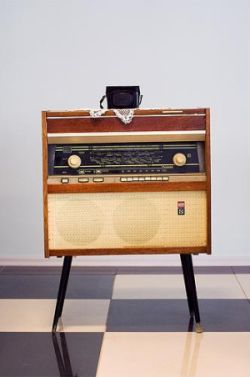The exposition presents items from the Riga Technical University Museum and the Radio Museum, as well as private collections, about 50 exhibits in total.

The exhibition curator is Edite Berzina – associate professor of the Art Academy of Latvia, the country’s leading expert in the history and theory of design. The initiator and the organiser of the exhibition is Rietumu Bank.
The main focus of the exhibition “Symbol and Legend of the Epoch”
is the history and development of design of legendary Latvian radios. The exhibition will present items manufactured in different periods, starting from the 1940s, which allows the restoration of a vivid dynamic picture of transformation of their external appearance, following the success of technological advances, the evolution of tastes and fashion, changing tendencies in applied design, public preferences and tastes.
Visitors of the exhibition will be able to see devices of different epochs and for various uses – from compact and portable valve and transistor receivers up to office and household radios, as well as exclusive equipment of luxury class. The most successful and famous examples of the Latvian radio industry are items and lines such as Rigonda, Festival, Riga, etc. A separate section of the exposition is dedicated to the legendary Spidola, which was released in different modifications starting from the 60s and the 90s.
As is popularly known, Riga has rich traditions in the manufacturing of radio equipment which are traced back to 1920. In the post-war years, several industrial groups, design bureaus and production plants were operating in Latvia, where the best specialists of Latvia radio engineering and radio design were employed. Riga radios were well-known and popular not only in the USSR territory, but also internationally – they crossed the ocean in a boat of a circumnavigator, and were even at the North Pole and in other most distant parts of the world.
“In the second half of the 20
th century over 41 million units of radio equipment and acoustic systems were manufactured at the Riga Radio Plant and Radiotehnika factory, of which about 10% were exported,” notes the exhibition curator Edite Berzina. “Regrettably, at the end of the 20
th century radio production was stopped in Riga, and there were objective reasons and circumstances for it. However, we must not forget about the time of prosperity and development of the Riga radio industry, we have to remember about the designers and engineers – all of whom carried the fame of Riga radios worldwide. I hope that this exhibition, which is organised according to a private initiative, will not remain the only one and that others will follow.”
Riga radios, as a rule, were distinguished not only for their successful design and high quality of manufacturing, but also for their excellent look. To produce the cases of the luxury line devices, valuable wood species, high quality fabrics, non-ferrous metals, ebonite and the first types of plastic were used. An especially elegant design was chosen for compact models, and models intended for export or special orders were performed in different colours.
“The exhibition opens the curtain of time over a whole big layer of the history of engineering and design. Its visitors will be able to see and evaluate the entire variety of the Latvian tradition and culture of radio manufacturing. The exhibits presented here are not only examples of high technical quality – they can provide real aesthetic pleasure.
I am sure that this exhibition will evoke nostalgic images and pleasant recollections for people of older generations. In the conditions of life of the 50s-60s, a Riga radio could easily become the most beautiful item in the interior of a modest flat of an ordinary Soviet family, not mentioning the fact of how much joy it was bringing. And portable transistors will definitely remind many people about the bright and romantic moments of their youth,” says the Member of the Council of Rietumu Bank Alexander Gafin.
The organisers of the exhibition express special gratitude to Inars Klavins, Riga Radio Plant specialist and the author of the book “Establishment and Growth of the Riga Radio Plant” for the support and Janis Jansons, laboratory technician of the Faculty of Electronics and Telecommunications of Riga Technical University, as well as JSC “VEF Radiotehnika RRR” and Riga Technical University for their cooperation and presented exhibits. Eleonora Gailisha Mass Media and Public Relations
Phone: +371-67020506
Fax: +371-67020563
E-mail:
[email protected]
